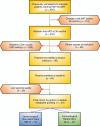A baseline metabolomic signature is associated with immunological CD4+ T-cell recovery after 36 months of antiretroviral therapy in HIV-infected patients
- PMID: 29280761
- PMCID: PMC5844590
- DOI: 10.1097/QAD.0000000000001730
A baseline metabolomic signature is associated with immunological CD4+ T-cell recovery after 36 months of antiretroviral therapy in HIV-infected patients
Abstract
Objectives: Poor immunological recovery in treated HIV-infected patients is associated with greater morbidity and mortality. To date, predictive biomarkers of this incomplete immune reconstitution have not been established. We aimed to identify a baseline metabolomic signature associated with a poor immunological recovery after antiretroviral therapy (ART) to envisage the underlying mechanistic pathways that influence the treatment response.
Design: This was a multicentre, prospective cohort study in ART-naive and a pre-ART low nadir (<200 cells/μl) HIV-infected patients (n = 64).
Methods: We obtained clinical data and metabolomic profiles for each individual, in which low molecular weight metabolites, lipids and lipoproteins (including particle concentrations and sizes) were measured by NMR spectroscopy. Immunological recovery was defined as reaching CD4 T-cell count at least 250 cells/μl after 36 months of virologically successful ART. We used univariate comparisons, Random Forest test and receiver-operating characteristic curves to identify and evaluate the predictive factors of immunological recovery after treatment.
Results: HIV-infected patients with a baseline metabolic pattern characterized by high levels of large high density lipoprotein (HDL) particles, HDL cholesterol and larger sizes of low density lipoprotein particles had a better immunological recovery after treatment. Conversely, patients with high ratios of non-HDL lipoprotein particles did not experience this full recovery. Medium very-low-density lipoprotein particles and glucose increased the classification power of the multivariate model despite not showing any significant differences between the two groups.
Conclusion: In HIV-infected patients, a baseline healthier metabolomic profile is related to a better response to ART where the lipoprotein profile, mainly large HDL particles, may play a key role.
Figures




Similar articles
-
Circulating metabolomic profile can predict dyslipidemia in HIV patients undergoing antiretroviral therapy.Atherosclerosis. 2018 Jun;273:28-36. doi: 10.1016/j.atherosclerosis.2018.04.008. Epub 2018 Apr 9. Atherosclerosis. 2018. PMID: 29677628
-
Impaired gut junctional complexes feature late-treated individuals with suboptimal CD4+ T-cell recovery upon virologically suppressive combination antiretroviral therapy.AIDS. 2016 Apr 24;30(7):991-1003. doi: 10.1097/QAD.0000000000001015. AIDS. 2016. PMID: 27028142
-
Glutaminolysis and lipoproteins are key factors in late immune recovery in successfully treated HIV-infected patients.Clin Sci (Lond). 2019 Apr 29;133(8):997-1010. doi: 10.1042/CS20190111. Print 2019 Apr 30. Clin Sci (Lond). 2019. PMID: 30952809
-
Immunological profiling of tuberculosis-associated immune reconstitution inflammatory syndrome and non-immune reconstitution inflammatory syndrome death in HIV-infected adults with pulmonary tuberculosis starting antiretroviral therapy: a prospective observational cohort study.Lancet Infect Dis. 2015 Apr;15(4):429-38. doi: 10.1016/S1473-3099(15)70008-3. Epub 2015 Feb 9. Lancet Infect Dis. 2015. PMID: 25672566 Free PMC article.
-
Multi-omics in HIV: searching insights to understand immunological non-response in PLHIV.Front Immunol. 2023 Aug 15;14:1228795. doi: 10.3389/fimmu.2023.1228795. eCollection 2023. Front Immunol. 2023. PMID: 37649488 Free PMC article. Review.
Cited by
-
Evaluation of Clinical Biomarkers Related to CD4 Recovery in HIV-Infected Patients-5-Year Observation.Viruses. 2022 Oct 18;14(10):2287. doi: 10.3390/v14102287. Viruses. 2022. PMID: 36298842 Free PMC article.
-
Immunological Efficacy and the Impact on Weight of Dolutegravir-Based Regimen in Antiretroviral Therapy (ART)-Naïve Patients with HIV Infection.Infect Drug Resist. 2024 Nov 7;17:4921-4933. doi: 10.2147/IDR.S484703. eCollection 2024. Infect Drug Resist. 2024. PMID: 39529794 Free PMC article.
-
Incomplete immune reconstitution in HIV/AIDS patients on antiretroviral therapy: Challenges of immunological non-responders.J Leukoc Biol. 2020 Apr;107(4):597-612. doi: 10.1002/JLB.4MR1019-189R. Epub 2020 Jan 22. J Leukoc Biol. 2020. PMID: 31965635 Free PMC article. Review.
-
The accumulation of plasma acylcarnitines are associated with poor immune recovery in HIV-infected individuals.BMC Infect Dis. 2021 Aug 12;21(1):808. doi: 10.1186/s12879-021-06525-6. BMC Infect Dis. 2021. PMID: 34384363 Free PMC article.
-
Mechanisms of HIV-immunologic non-responses and research trends based on gut microbiota.Front Immunol. 2024 Dec 26;15:1378431. doi: 10.3389/fimmu.2024.1378431. eCollection 2024. Front Immunol. 2024. PMID: 39802299 Free PMC article. Review.
References
-
- Battegay M, Nüesch R, Hirschel B, Kaufmann GR. Immunological recovery and antiretroviral therapy in HIV-1 infection. Lancet Infect Dis 2006; 6:280–287. - PubMed
-
- Corbeau P, Reynes J. Immune reconstitution under antiretroviral therapy: the new challenge in HIV-1 infection. Blood 2011; 117:5582–5590. - PubMed
-
- Pacheco YM, Jarrin I, Rosado I, Campins AA, Berenguer J, Iribarren JA, et al. Increased risk of non-AIDS-related events in HIV subjects with persistent low CD4 counts despite cART in the CoRIS cohort. Antiviral Res 2015; 117:69–74. - PubMed
-
- Pacheco YM, Jarrín I, Del Amo J, Moreno S, Iribarren JA, Viciana P, et al. Risk factors, CD4 long-term evolution and mortality of HIV-infected patients who persistently maintain low CD4 counts, despite virological response to HAART. Curr HIV Res 2009; 7:612–619. - PubMed
-
- Massanella M, Negredo E, Clotet B, Blanco J. Immunodiscordant responses to HAART – mechanisms and consequences. Expert Rev Clin Immunol 2013; 9:1135–1149. - PubMed
Publication types
MeSH terms
Substances
LinkOut - more resources
Full Text Sources
Other Literature Sources
Medical
Research Materials

